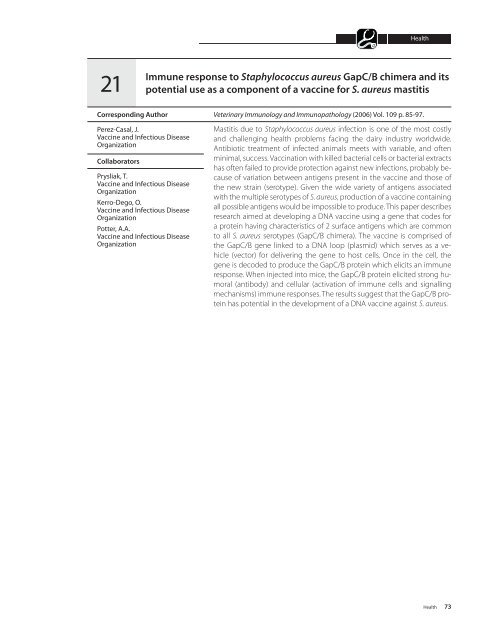Health19Effects of noncytopathic type 2 Bovine viral diarrhea virus on theproliferation of bone marrow progenitor cellsCorresponding AuthorWood, R.D.University of GuelphCollaboratorsKeller, S.L.University of GuelphJefferson, B.J.University of GuelphJacobs, R.M.University of GuelphCanadian Journal of Veterinary Research (2006) Vol. 70 p. 20-27.Bovine viral diarrhea virus (BVDV) causes significant economic loss to thecattle industry. Although the virus usually causes only mild or subclinicaldisease, a severe acute form of BVD infection may produce unusually highmorbidity (sickness) and mortality (death) rates in both calves and adults.Clinical signs include fever, loss of appetite, diarrhea and severe depressionof both red and white blood cell (WBC) counts which may predispose animalsto secondary viral and bacterial infections. The objective of this studywas to determine whether the low WBC count (neutropenia) was due toa reduction of WBC proliferation in bone marrow. Groups of calves wereinfected with one of 2 strains of BVDV of high (HV) or low virulence (LV).WBC proliferation was measured by culturing samples of bone marrowdrawn from the calves before and each day for 5 days after being infected.BVDV was found in bone marrow cells as soon as 2 or 3 days after infectionand neutropenia developed in both calf groups. However, WBC counts reboundedearlier in calves infected with the LV than in those given the HVstrain. WBC proliferation decreased significantly in calves infected with HVwhile, in those given LV, it was not different from control calves. The resultsof this study support the hypothesis that the neutropenia experienced bycalves infected with the severe acute form of BVDV is due, at least in part,to reduced WBC proliferation in bone marrow.20Clopidogrel induced suppression of bovine platelet activation invitro and a preliminary study of its effect on the development ofMannheimia haemolytica induced pneumoniaCorresponding AuthorCoomber, B.L.University of GuelphCollaboratorsMitchell, G.B.University of GuelphStarr, A.E.University of GuelphMinhas, K.University of GuelphTamblyn, A.University of GuelphShewen, P.E.University of GuelphGentry, P.A.University of GuelphThe Veterinary Journal (2006) Vol. 171 p. 126-134.Shipping fever (SF) causes significant economic loss to the cattle industry.SF is a result of stress, viral infection or other challenge leading to bacterialpneumonia, primarily caused by Mannheimia (formerly Pasteurella) haemolytica,a normal inhabitant of cattle nasal passages. The host respondsto the initial challenge with an inflammatory response resulting in congestionof the lung alveoli due to an accumulation of white blood cells,platelets and fibrin, the protein which forms blood clots. Reduced lungfunction resulting from this congestion favours the proliferation of M. haemolyticain the alveoli. The objective of this study was to clarify the roleof platelets in the inflammatory response. Platelet function was examinedin blood samples drawn from calves treated with clopidogrel, a plateletantagonist. Clopidogrel treatment produced consistent reduction in normalplatelet function. When clopidogrel-treated calves were challengedwith an intra-tracheal injection of M. haemolytica, there was an inhibitionof platelet function in affected areas of the lungs. Compared with controlcalves, clopidogrel-treated calves had similar amounts of fibrin depositionand enhanced fibrous tissue formation in their lungs.72 Highlights in Canadian Dairy Cattle Research - 2007
Health21Immune response to Staphylococcus aureus GapC/B chimera and itspotential use as a component of a vaccine for S. aureus mastitisCorresponding AuthorPerez-Casal, J.Vaccine and Infectious DiseaseOrganizationCollaboratorsPrysliak, T.Vaccine and Infectious DiseaseOrganizationKerro-Dego, O.Vaccine and Infectious DiseaseOrganizationPotter, A.A.Vaccine and Infectious DiseaseOrganizationVeterinary Immunology and Immunopathology (2006) Vol. 109 p. 85-97.Mastitis due to Staphylococcus aureus infection is one of the most costlyand challenging health problems facing the dairy industry worldwide.Antibiotic treatment of infected animals meets with variable, and oftenminimal, success. Vaccination with killed bacterial cells or bacterial extractshas often failed to provide protection against new infections, probably becauseof variation between antigens present in the vaccine and those ofthe new strain (serotype). Given the wide variety of antigens associatedwith the multiple serotypes of S. aureus, production of a vaccine containingall possible antigens would be impossible to produce. This paper describesresearch aimed at developing a DNA vaccine using a gene that codes fora protein having characteristics of 2 surface antigens which are commonto all S. aureus serotypes (GapC/B chimera). The vaccine is comprised ofthe GapC/B gene linked to a DNA loop (plasmid) which serves as a vehicle(vector) for delivering the gene to host cells. Once in the cell, thegene is decoded to produce the GapC/B protein which elicits an immuneresponse. When injected into mice, the GapC/B protein elicited strong humoral(antibody) and cellular (activation of immune cells and signallingmechanisms) immune responses. The results suggest that the GapC/B proteinhas potential in the development of a DNA vaccine against S. aureus.Health 73





